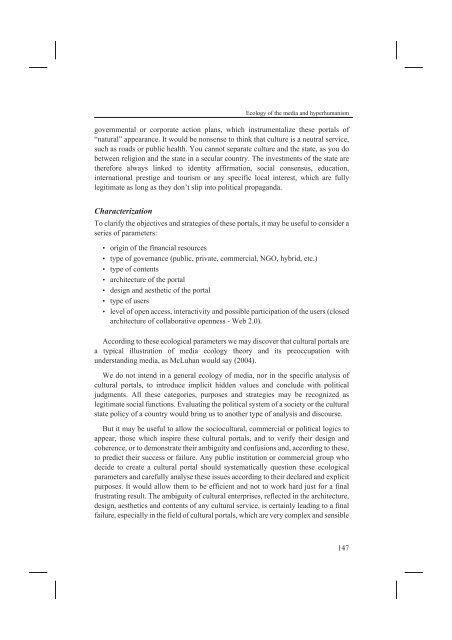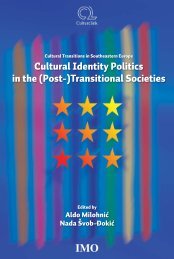D:\Documents and Settings\Ana\My Documents\Biserka-knjiga ...
D:\Documents and Settings\Ana\My Documents\Biserka-knjiga ...
D:\Documents and Settings\Ana\My Documents\Biserka-knjiga ...
You also want an ePaper? Increase the reach of your titles
YUMPU automatically turns print PDFs into web optimized ePapers that Google loves.
governmental or corporate action plans, which instrumentalize these portals of<br />
“natural” appearance. It would be nonsense to think that culture is a neutral service,<br />
such as roads or public health. You cannot separate culture <strong>and</strong> the state, as you do<br />
between religion <strong>and</strong> the state in a secular country. The investments of the state are<br />
therefore always linked to identity affirmation, social consensus, education,<br />
international prestige <strong>and</strong> tourism or any specific local interest, which are fully<br />
legitimate as long as they don’t slip into political propag<strong>and</strong>a.<br />
Characterization<br />
Ecology of the media <strong>and</strong> hyperhumanism<br />
To clarify the objectives <strong>and</strong> strategies of these portals, it may be useful to consider a<br />
series of parameters:<br />
• origin of the financial resources<br />
• type of governance (public, private, commercial, NGO, hybrid, etc.)<br />
• type of contents<br />
• architecture of the portal<br />
• design <strong>and</strong> aesthetic of the portal<br />
• type of users<br />
• level of open access, interactivity <strong>and</strong> possible participation of the users (closed<br />
architecture of collaborative openness - Web 2.0).<br />
According to these ecological parameters we may discover that cultural portals are<br />
a typical illustration of media ecology theory <strong>and</strong> its preoccupation with<br />
underst<strong>and</strong>ing media, as McLuhan would say (2004).<br />
We do not intend in a general ecology of media, nor in the specific analysis of<br />
cultural portals, to introduce implicit hidden values <strong>and</strong> conclude with political<br />
judgments. All these categories, purposes <strong>and</strong> strategies may be recognized as<br />
legitimate social functions. Evaluating the political system of a society or the cultural<br />
state policy of a country would bring us to another type of analysis <strong>and</strong> discourse.<br />
But it may be useful to allow the sociocultural, commercial or political logics to<br />
appear, those which inspire these cultural portals, <strong>and</strong> to verify their design <strong>and</strong><br />
coherence, or to demonstrate their ambiguity <strong>and</strong> confusions <strong>and</strong>, according to these,<br />
to predict their success or failure. Any public institution or commercial group who<br />
decide to create a cultural portal should systematically question these ecological<br />
parameters <strong>and</strong> carefully analyse these issues according to their declared <strong>and</strong> explicit<br />
purposes. It would allow them to be efficient <strong>and</strong> not to work hard just for a final<br />
frustrating result. The ambiguity of cultural enterprises, reflected in the architecture,<br />
design, aesthetics <strong>and</strong> contents of any cultural service, is certainly leading to a final<br />
failure, especially in the field of cultural portals, which are very complex <strong>and</strong> sensible<br />
147



